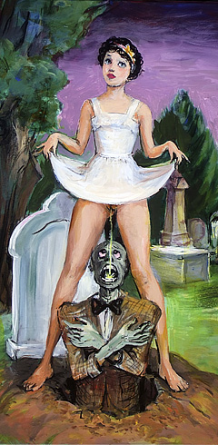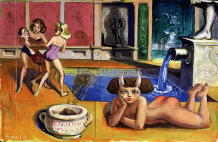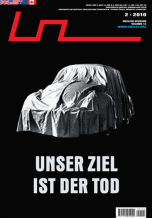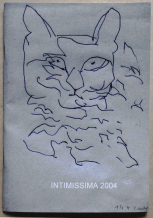| Zeitschrift Umělec 2003/3 >> IS THERE ANY CONTEMPORARY CULTURE IN KOSOVO? | Übersicht aller Ausgaben | ||||||||||||
|
|||||||||||||
IS THERE ANY CONTEMPORARY CULTURE IN KOSOVO?Zeitschrift Umělec 2003/301.03.2003 Sezgin Boynik | focus | en cs |
|||||||||||||
|
"Since 1999, the international force of
NATO and UNMIK (United Nations Interim Administration Mission in Kosovo) has created partial freedom for people who live in Kosovo. For over ten years Yugoslavia had taken from Albanians all their basic rights to education, work, health and culture. So the 1999 “Turning Point” was considered a wave of freedom among the international public. Albanians thought of this situation as not only an alternative new wave, but one that also held potential for new possibilities. As a result this “new” event has begun to dwell within all spheres of politics, economics, international relations and culture. Going back, from the mid-1980s to the end of the ‘90s a passive underground resistance was in place. Shkelzen Maliqi, who had been an important figure in the alternative movement since 1980s and who wrote extensively on this issue, defined this resistance as a “parallel institution,” which could be defined as a paradigmatic method of resistance. During the domination (now labeled “socialism”) of Albania and later, the post-socialist transition period frequently used this method. When Serbians took away the autonomous rights (legislative power in parliament, the closing down of the Science and Art Academy, dismissal of Albanians from their jobs, the banning of the Albanian language education) that were given by Tito to Albanian in 1974, Albanians began to create their own underground network — instead of launching a visible, planned resistance. Although this kind of resistance strengthened Albanians’ consciousness, a state of disorganization arose, for people were unable to express themselves in public. For example, Maliqi blamed disagreements and disorder as being the main problems among Albanian Parties and this didn’t change after 1999. Today people are no longer oppressed by a regime, so instead the problem has manifested itself as an identity crisis within Kosovo. The most discussed subject by intellectuals after 1999 in the newly established Kosovo was the Albanian identity: “How should Albanian identity be defined?” Contemporary culture and art journal Java dwelled on this subject for a long time, and it is still being discussed. The focus is mostly centered on the alternative national identity, the casualties of authentic identity, and the symptoms of this in the contemporary art scene. The identity problem could be considered an extension of non-representation in the public sphere. This problem was created by the resistance of the parallel institutions that were widespread among Albanians since the 1980s, and instead of open discussion in public, everybody created his or her own isolated space. Therefore, the issue of a movement in Kosovo contemporary art must be looked at from within this social aspect. Curator Harald Szeemann has stressed the importance of the Albanian phenomenon, and he deals mainly with Albanian artists in the introduction to the exhibition catalogue for Blood and Honey. (We should be careful about the differences in both the issues and underground resistance styles of Albanians and Kosovo’s Albanians. Even though both issues and resistance styles seem similar, the principals are very distinct. First, the oppression in Albania was established through ideology and bureaucratic hegemony; however in Kosovo oppression was put in place through nationalistic and police-state hegemony.) After this exhibition, René Block curated In der Schusten Der Balkans, which was an important input for Kosovo contemporary art. When Block was in Kosovo he was a “messiah,” a savior in Pristina. He said Pristina was the center of the avant-garde in the Balkans in an interview in Java magazine. A statement that catalyzed avant-garde euphoria here. As I explained, parallel institutions became the symbol and tradition of the alternative cultural and political resistance. While no Albanian art superstar exists, the most prominent Albanian artist from Kosovo, Sislej Xhafa, has become meaningful to the international art scene. The most important and well-known of Xhafa’s first performances was in 1997 for the Venice Biennale, where the artist participated, but illegally, and in an underground fashion. Xhafa was himself a parallel pavilion, and he presented the Albania that had not been invited to the show. This was done in the same underground and parallel resistance style that is so well known in Kosovo. Xhafa often speaks about clandestine and underground lifestyles in his work. He lived a long time in Pristina, and is the son of Xhevdet Xhafa, a representative of Kosovo modern art during the 1960s and 1970s. After 1999, he frequently visited Pristina from New York (where he now lives) and put on many presentations and gave many speeches (especially during 2001 and 2002, the post-Duchamp seminars he did with Mehmet Behkuki were important), which had influence on the post-René Block period of Kosovo artists. As an Albanian, Xhafa’s clandestine approach was significant, as he applied himself and succeeded in the international arena. With his photos of UÇK leaders, Albanian Mafioso in Italy and his borderline profane style, Xhafa was a true Albanian; he was a symbol of “Albanian vigilante” danger, and Xhafa was always aware of the labels and enjoyed playing with them. But even more Albanian is artist Sokol Beqiri. Beqiri was active when art was being presented as a parallel institution in various areas, cafes and schools, and Beqiri was one of the first artists in Kosovo’s most political period to make contemporary art as “avant-garde” resistance. After 1999, Beqiri’s work and lifestyle (his drinking, his refusal to leave his birth place of Peja, his experiences during the war and authentic Albanian folk attitudes) greatly influenced the younger generation. Aggression and openness in his works revealed the identity crisis and the traumas that he had lived through in Kosovo. He presented with great clarity the everyday fear that Albanians had of the Serbian police and the brutality of para-military forces. Of Kosovo contemporary artists, only Sokol Beqiri and Erzen Shkolloli from Peja have succeeded in opening discussion on political issues in a very serious manner while in a discursive sphere. However, despite all of this, the answer to the original question is still in the negative: there is no contemporary culture in Pristina. Both economics and pedagogical factors could be blamed for this. However the most important reason is this tradition of isolated and underground resistance, which has created the discursive sphere in Kosovo public space. Even though there is similarity and solidarity among the young artists in Pristina who have begun to be active on the international platform (Jahup Ferri, Driton Hajredinaj, Dren Maliqi, Lulezim Zeqiri and Tahar Alemdar), there is no continuity in Kosovo’s contemporary art history. Modernist artists like Muslim Muliqi, Rexhep Ferri, Xhevdet Xhafa, who were very active and at the academy between 1960 and 1990, are meaningless to the new wave of artists. This attitude of young “new wave” artists shouldn’t be compared to western artists who criticize past generations and consciously reject following them. This is because the young artists of Kosovo have neither dealt with, nor faced, the artists of their past generation. They even think of this past as an empty period. The “collective amnesia” that once appeared in post-socialist countries shows itself distinctly in Kosovo. Maybe “amnesia” (called purification by Migjen Kelmendi in one of our conversations) as a traumatic experience is a good psychological strategy for countries in transition. However this healing strategy causes a kind of “a-historicity” in the social sphere. The outcome is always a postmodern conservative illusion that transforms history into spectacle. Therefore the new wave artists in Pristina deny and pretend not see thirty years of art history in their artwork and everyday lives. Consequently, most young artists make reference to western artists like Christo (Sokol Beqiri), John Lennon and Yoko Ono (Yakup Feri), Damien Hirst (Lulezim Zeqiri), Barney and Viola ( Driton Hajredinaj) with an attitude of parody and irony in their work, but they never refer to their own older generation of artists. What’s more, the old modernist Kosovo artists are still teaching the young new artists. (When we mention artists from 1960 to 1990, we are referring to Albanian artists. However, there are also important Serbian artists. To consider those artists taboo is another aspect of the collective amnesia.) The art students in the Fine Art Academy of Pristina rebelled against the older teachers during a two-month period between 2001 and 2002. Despite an effective rebellion by the young students, they were unable to take it into the public sphere. In his article written for the catalogue to the René Block exhibition, Shkelzen Maliqi’s opinion that this event was a starting point is a difficult sell. There are two reasons why the rebellion failed and cannot be used as a kind of starting point: First, the rebellion was organized by a “hard-core” group that was too small; and second, they were unable to transform the revolt and take it onto a planned-out, and critical level. In short, the revolt was important input, but it still lacked a manifesto that capable of defining a Kosovo new wave. On the other hand, this rebellion and interest in the explosion of contemporary art produced a parallel institutionalization in Kosovo contemporary art. But this time the parallel institutionalization had many distinct features from the resistance of the Albanian underground of the 1980s. The new wave artists harshly criticized Albanian national history and the symbols embodying profound cultural roots. Sokol Beqiri, who began this style of criticism, uses the language of sailors, the Albanian flag, his family, and the message “Fuck You.” And Erzen Shkolloli (from Peja) made a video presenting the local singer Fejza Shkurte, who sings national songs. In the video, Fejza Shkurte sings, “Don’t Play with Albania,” threatening the world. The white and isolated space she is situated in shows the emptiness and amnesia of UNMIK. Despite the existence of brave and self-critical works in Albanian culture, and there are many examples, no movement or public discussion as been stirred up. The contemporary art movement, considered a parallel institution, couldn’t create an opposition discourse, and was never established in a consciously open space. On the other hand the young new wave artists are aware of cultural and political happenings and discourses in the world, and they have access to a wide range of information. Among the new wave artists there are signs of a subculture movement under construction. Nicholas Bourriaud mentions in his book Relational Aesthetics “social exchange” within contemporary art. This social exchange doesn’t happen among galleries, audiences and artists in Pristina; the young new wave artists live the social exchange itself, in Pristina’s streets, cafes, odd passageways and one interesting music shop called “Ginger” — the most contemporary place in Pristina. In a city where everybody is a fan of Radiohead, only in this shop can you find records by Madness, Spaceman 3, Gang of Four, Iggy Pop, and CDs by Can, John Zorn, Les Negres Vertes, Residents, Laibach. Ginger’s owner, Armend, says that modern life in Pristina is divided into two groups: “charlatans who think that they’re contemporary and others who want to be like them.” The rest are Armend’s close friends. The cafes at the front of this passage are home to young artists, Hip-Hop musicians and fans (especially NR and TNT), and hash addicts. But even if these places create a kind of underground culture, this is not enough. The “Papçe” who began making videos, describe this situation very well: Underfuckinground! The fact is, Pristina is living mainstream kitsch, and it is impossible to get rid of the pop culture. There was excitement in the air as Kosovo was being established in 1999. Four years have gone by, and Kosovo still has no status, and it seems that it will not gain one. Only one contemporary artist ventures to criticize this situation: Erzen Shkolloli, who did a photomontage called: “UNMIK’s-Sold.” Even if the artists are aware of the situation, they are still unable to create a political and public discourse, and a manifesto with a political position does not exist. The underground position is a present day problem of visual culture — there is no need to be hopeless for the future. Because of the new generation of Kosovo artists, all new works assist in the construction of what Beuys called one critical “social sculpture.” "
01.03.2003
Empfohlene Artikel
|
|||||||||||||
|
04.02.2020 10:17
Letošní 50. ročník Art Basel přilákal celkem 93 000 návštěvníků a sběratelů z 80 zemí světa. 290 prémiových galerií představilo umělecká díla od počátku 20. století až po současnost. Hlavní sektor přehlídky, tradičně v prvním patře výstavního prostoru, představil 232 předních galerií z celého světa nabízející umění nejvyšší kvality. Veletrh ukázal vzestupný trend prodeje prostřednictvím galerií jak soukromým sbírkám, tak i institucím. Kromě hlavního veletrhu stály za návštěvu i ty přidružené: Volta, Liste a Photo Basel, k tomu doprovodné programy a výstavy v místních institucích, které kvalitou daleko přesahují hranice města tj. Kunsthalle Basel, Kunstmuseum, Tinguely muzeum nebo Fondation Beyeler.
|
































 We Are Rising National Gallery For You! Go to Kyjov by Krásná Lípa no.37.
We Are Rising National Gallery For You! Go to Kyjov by Krásná Lípa no.37.
Kommentar
Der Artikel ist bisher nicht kommentiert wordenNeuen Kommentar einfügen